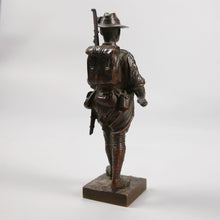ANZAC - A Gallipoli Campaign Bronze Figure, 1920
Adding product to your cart
Height: 22cm (8.7in)
Patinated bronze. Modelled as a marching infantryman of the Australian and New Zealand Army Corps in shirt sleeve order and distinctive slouch hat with upturned brim displaying the rising sun badge of the Australian Imperial Forces, equipped with Short Magazine Lee Enfield rifle, pack, haversack, water-bottle, entrenching tool head, and helve attached to the bayonet scabbard, all suspended from Pattern 1908 Web Infantry Equipment.
Read more
On the morning of the 25 April 1915, men of the Australian and New Zealand troops landed on the Gallipoli Peninsula with the Allied objective of capturing Constantinople. The first Anzacs were put ashore north of their intended landing zone and it rapidly became clear that the plan to destroy the Ottoman defences had failed. Under intense artillery fire, the Anzacs dug in and fought on for more than ten months. Both sides suffered heavy losses before the Anzacs were evacuated with rest of the Allies on 9 January 1916. The Anzac experience of 1915 had a profound effect on the collective, national, consciousnesses of Australia and New Zealand, and by the 1920s, Anzac Day had become a public holiday with ceremonial services at dawn in recognition of the 8141 Australians and 2779 New Zealanders killed in the Dardanelles campaign and the time the Corps spent fighting on the Gallipoli Peninsula.








